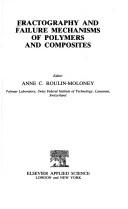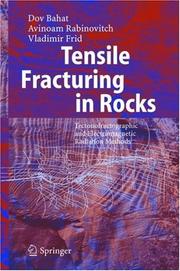| Listing 1 - 5 of 5 |
Sort by
|

ISBN: 1851662960 9781851662968 Year: 1989 Publisher: London: Elsevier applied science,
Abstract | Keywords | Export | Availability | Bookmark
 Loading...
Loading...Choose an application
- Reference Manager
- EndNote
- RefWorks (Direct export to RefWorks)
Composite materials --- Fractography --- Polymers --- Composites --- Fractographie --- Polymères --- Fracture --- Rupture --- -Fractography --- -Polymere --- Polymeride --- Polymers and polymerization --- Macromolecules --- Microfractography --- Electron microscopy --- Fracture mechanics --- Metallography --- Metals --- Composites (Materials) --- Multiphase materials --- Reinforced solids --- Solids, Reinforced --- Two phase materials --- Materials --- -Fracture --- Polymères --- -Microfractography --- Polymere
Book
ISBN: 0915802112 Year: 1979 Publisher: Chicago (Ill.): IIT research institute
Abstract | Keywords | Export | Availability | Bookmark
 Loading...
Loading...Choose an application
- Reference Manager
- EndNote
- RefWorks (Direct export to RefWorks)
Microscopy, Electron, Scanning. --- Fractography --- -Microfractography --- Electron microscopy --- Fracture mechanics --- Metallography --- Metals --- Handbooks, manuals, etc --- Fracture --- Microscopy, Electron, Scanning --- Electron Scanning Microscopy --- Scanning Electron Microscopy --- Electron Microscopies, Scanning --- Electron Microscopy, Scanning --- Electron Scanning Microscopies --- Microscopies, Electron Scanning --- Microscopies, Scanning Electron --- Microscopy, Electron Scanning --- Microscopy, Scanning Electron --- Scanning Electron Microscopies --- Scanning Microscopies, Electron --- Scanning Microscopy, Electron --- Microfractography --- Handbooks, manuals, etc.

ISBN: 0471558397 Year: 1993 Publisher: New York (N.Y.) : Wiley,
Abstract | Keywords | Export | Availability | Bookmark
 Loading...
Loading...Choose an application
- Reference Manager
- EndNote
- RefWorks (Direct export to RefWorks)
Fractografie --- Fractographie --- Fractography --- Microfractography --- 621.18 --- Metals --- -Steam-boilers --- -Steam generators --- Boilers --- Engines --- Pressure vessels --- Metallic elements --- Chemical elements --- Ores --- Metallurgy --- Electron microscopy --- Fracture mechanics --- Metallography --- Steam boilers. Steam generators. Steam plant in general. Layout of boilers, main components and elements --- Fracture --- Failures --- Fractography. --- Steam-boilers --- Fracture. --- Failures. --- -Steam boilers. Steam generators. Steam plant in general. Layout of boilers, main components and elements --- 621.18 Steam boilers. Steam generators. Steam plant in general. Layout of boilers, main components and elements --- -Microfractography --- Steam generators --- Failure of metals --- Fracture of metals --- Failures in steam-boilers --- System failures (Engineering) --- Failure --- Testing --- Steam-boilers - Failures. --- Metals - Fracture.
Book
ISBN: 0323297994 0323242723 9780323297998 9780323242721 Year: 2015 Publisher: Amsterdam, [Netherlands] : William Andrew,
Abstract | Keywords | Export | Availability | Bookmark
 Loading...
Loading...Choose an application
- Reference Manager
- EndNote
- RefWorks (Direct export to RefWorks)
Fractography in Failure Analysis of Polymers provides a practical guide to the science of fractography and its application in the failure analysis of plastic components. In addition to a brief background on the theory of fractography, the authors discuss the various fractographic tools and techniques used to identify key fracture characteristics. Case studies are included for a wide range of polymer types, applications, and failure modes, as well as best practice guidelines enabling engineers to apply these lessons to their own work. Detailed images and their appropriate context are presen
Materials--Fatigue. --- Polymers -- Fracture. --- Materials Science --- Chemical & Materials Engineering --- Engineering & Applied Sciences --- 62-039.5 --- Polymers --- Fractography --- Failure analysis (Engineering) --- Analysis, Failure (Engineering) --- Quality control --- System failures (Engineering) --- Microfractography --- Electron microscopy --- Fracture mechanics --- Metallography --- Metals --- 62-039.5 Polymer matrix composites --- Polymer matrix composites --- Fracture --- Materials --- Fatigue. --- Fracture. --- Fatigue of materials --- Fatigue testing --- Strains and stresses --- Strength of materials --- Structural failures --- Vibration --- Dynamic testing --- Testing

ISBN: 1280234601 9786610234608 3540266143 3540214569 3642059872 Year: 2005 Publisher: Berlin ; New York : Springer,
Abstract | Keywords | Export | Availability | Bookmark
 Loading...
Loading...Choose an application
- Reference Manager
- EndNote
- RefWorks (Direct export to RefWorks)
‘Tensile Fracturing in Rocks’ presents field observations on fracturing of sedim- tary rocks and granite outcrops from various provinces in three continents. It also combines results of recent experiments conducted at different laboratories around the world with current theories on fracturing. In treating faults, this book limits itself to faults that are associated with joint sets produced by definable causes and occasi- ally to cases where interaction between the two types of fracture – faults and joints – is not clear. The book’s subject matter is divided over six chapters, which are briefly described below. Chapter 1 summarizes current key concepts in fracture physics. It starts with a pr- entation of the elastic theory of fracture, and concentrates on the results of linear el- tic fracture mechanics. The chapter touches also upon other fracture properties, e.g., crack nucleation, dynamic fracturing and slow fracturing processes. Nucleation is - dressed by statistical mechanics methods incorporating modern approaches of th- mal and fiber bundle processes. The analyses of dynamic fracturing and slow fract- ing focus on the differences, as compared to the linear elastic approach. The cont- versy in interpreting experimental dynamic results is highlighted, as are the surface morphology patterns that emerge in fracturing and the non-Griffith crack extension criterion in very slow fracturing processes.
Rocks --- Granite outcrops --- Geology, Structural. --- Fractography. --- Electromagnetic waves. --- Fracture. --- Testing. --- Electromagnetic energy --- Electromagnetic radiation --- Electromagnetic theory --- Waves --- Rock mechanics --- Microfractography --- Electron microscopy --- Fracture mechanics --- Metallography --- Metals --- Geotectonics --- Structural geology --- Tectonics (Geology) --- Physical geology --- Granite --- Outcrops (Geology) --- Petrology --- Stone --- Fracture --- Hydraulic engineering. --- Mineralogy. --- Geology. --- Physical geography. --- Structural Geology. --- Geoengineering, Foundations, Hydraulics. --- Geophysics/Geodesy. --- Hydrogeology. --- Geography --- Geognosy --- Geoscience --- Earth sciences --- Natural history --- Crystallography --- Minerals --- Engineering, Hydraulic --- Engineering --- Fluid mechanics --- Hydraulics --- Shore protection --- Structural geology. --- Engineering geology. --- Engineering—Geology. --- Foundations. --- Hydraulics. --- Geophysics. --- Geohydrology --- Geology --- Hydrology --- Groundwater --- Geological physics --- Terrestrial physics --- Physics --- Flow of water --- Water --- Hydraulic engineering --- Jets --- Architecture --- Building --- Structural engineering --- Underground construction --- Caissons --- Earthwork --- Masonry --- Soil consolidation --- Soil mechanics --- Walls --- Civil engineering --- Geology, Economic --- Flow --- Distribution --- Details
| Listing 1 - 5 of 5 |
Sort by
|

 Search
Search Feedback
Feedback About UniCat
About UniCat  Help
Help News
News